Environmental factors governing spatio-temporal series of aquatic vegetation in the Bagnas lagoon
IF 2.6
3区 地球科学
Q1 MARINE & FRESHWATER BIOLOGY
引用次数: 0
Abstract
Macrophytes are a key component of lagoon ecosystems, and the spatio-temporal variation of their biomass reflects the effect of environmental drivers. Understanding these dynamics is essential for managing, preserving and anticipating the fate of such fragile ecosystems. First, using both satellite data and field observations, we showcase here a machine learning approach to accurately detect submerged vegetation in a preserved lagoon in South France, the Bagnas lagoon. Second, we investigate the statistical relationship between the surface area of Stuckenia pectinata and abiotic factors known to influence the life history of this aquatic plant. We thus identify and evaluate the factors that most impact Stuckenia pectinata population dynamics within the lagoon. We find that water temperature, salinity, and depth are significantly related to submerged aquatic vegetation (SAV) coverage. We show that the SAV surface area reaches a peak during summer, which can vary across years. Furthermore, we examine the lifetime distribution of SAV during each year cycle across the pond. We show that the average annual lifespan differs significantly from one year to the next, which can be explained by annual differences in exposure time to sufficiently high water levels.
控制巴格纳斯泻湖水生植被时空序列的环境因子
大型植物是泻湖生态系统的重要组成部分,其生物量的时空变化反映了环境驱动因素的影响。了解这些动态对于管理、保护和预测这些脆弱生态系统的命运至关重要。首先,利用卫星数据和实地观测,我们在这里展示了一种机器学习方法,可以准确地检测法国南部巴格纳斯泻湖保存完好的泻湖中的淹没植被。其次,我们研究了猪链球菌的表面积与影响这种水生植物生活史的非生物因子之间的统计关系。因此,我们确定并评估了最影响泻湖内pectinata种群动态的因素。研究发现,水温、盐度和水深与水下水生植被(SAV)覆盖度显著相关。我们发现,SAV表面积在夏季达到峰值,这在不同年份可能有所不同。此外,我们还研究了整个池塘在每个年周期内SAV的寿命分布。我们表明,每年的平均年寿命与下一年有显着差异,这可以用暴露于足够高的水位的时间的年度差异来解释。
本文章由计算机程序翻译,如有差异,请以英文原文为准。
求助全文
约1分钟内获得全文
求助全文
来源期刊
CiteScore
5.60
自引率
7.10%
发文量
374
审稿时长
9 months
期刊介绍:
Estuarine, Coastal and Shelf Science is an international multidisciplinary journal devoted to the analysis of saline water phenomena ranging from the outer edge of the continental shelf to the upper limits of the tidal zone. The journal provides a unique forum, unifying the multidisciplinary approaches to the study of the oceanography of estuaries, coastal zones, and continental shelf seas. It features original research papers, review papers and short communications treating such disciplines as zoology, botany, geology, sedimentology, physical oceanography.

 求助内容:
求助内容: 应助结果提醒方式:
应助结果提醒方式:


